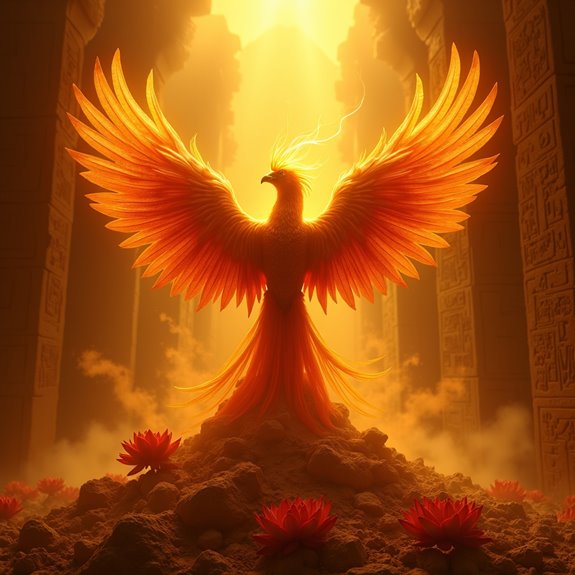What Do Phoenix Legends Say About Rebirth?
Phoenix legends resonate deeply with the concept of rebirth, showcasing humanity’s desire to rise anew after hardship. These mythical creatures, often depicted as emerging from their own ashes, offer profound insights into resilience and transformation. Across various cultures, they signify hope amid despair. But what specific stories and beliefs shape our understanding of this cyclical nature of life? Exploring these tales reveals intriguing connections that might challenge one’s perspective on personal renewal.
Introduction

In a world where trials forge resilience, the concept of legends often intertwines with themes of rebirth. One of the most enthralling tales involves the Phoenix, a mythical bird known for its ability to rise anew from its ashes. This emblem of transformation serves as a powerful metaphor for overcoming adversity and embracing renewal. Across cultures, the Phoenix represents hope, resurrection, and the eternal cycle of life. As individuals face challenges, the legend of the Phoenix inspires them to find strength in struggle, reminding them that endings can lead to new beginnings. By exploring these timeless tales, one can appreciate the deep-rooted connection between suffering, growth, and the transformative power of rebirth that continues to resonate today.
Ancient Egyptian Mythology Influence

While tales of the Phoenix resonate across numerous cultures, Ancient Egyptian mythology provides a particularly rich backdrop for understanding its significance. In this tradition, the Bennu bird, often associated with the Phoenix, symbolizes rebirth and renewal. The Bennu emerges from the ashes of its predecessor, embodying the cycle of life, death, and resurrection. Ancient Egyptians believed this bird arose from the benben stone at Heliopolis, connecting it to the sun god Ra and the concept of eternal life. Rituals and texts emphasize the Bennu’s role in cosmic balance and regeneration. These mythological elements highlight humanity’s enduring fascination with resurrection, making the Bennu a key figure in understanding the broader themes of renewal and transformation within ancient beliefs.
Notable Cases or Sightings

Notable sightings of the Phoenix across history often spark intrigue and fascination. In ancient Greece, historians documented instances of the mythical bird during significant events, believing its appearance heralded change. One famed sighting occurred in 15 AD, reported by an esteemed Roman naturalist, who claimed to witness a radiant creature flying over Egypt’s skies. The Middle Ages also featured sightings, with various texts describing a fiery bird reborn in flames, often seen near burning trees or restless fires. More recently, in the 20th century, a peculiar sighting in Arizona left witnesses claiming they saw a vibrant, flaming figure dance above the horizon at sunset, reigniting discussions about the Phoenix’s enduring legacy as a symbol of renewal and transformation.
Common Theories or Explanations
The fascination with Phoenix sightings has led to a variety of theories and explanations regarding this legendary creature. Many believe the Phoenix symbolizes renewal and transformation, embodying the cyclical nature of life. Others suggest that these tales stem from ancient cultures’ observations of natural phenomena like sunrises and wildfires, which evoke images of rebirth. Some scholars argue that the Phoenix represents human struggle, illustrating how individuals can rise from their adversities. Additionally, some propose that the legend aims to explain mortality, offering hope by suggesting there’s life beyond death. Collectively, these theories reflect humanity’s deep-seated desire for rebirth and immortality, demonstrating the Phoenix’s enduring appeal across cultures and generations.
Frequently Asked Questions
What Do Phoenix Legends Symbolize in Different Cultures?
Phoenix legends symbolize transformation, immortality, and renewal across various cultures. They often embody hope, resilience, and the cyclical nature of life. Different traditions emphasize their unique narratives, yet the essence of rebirth remains universally recognized.
How Is the Phoenix Represented in Modern Literature?
In modern literature, the phoenix often symbolizes resilience and transformation. Characters face adversity, rise from defeat, and embrace change, embodying the spirit of renewal. Their journeys inspire readers, highlighting the power of hope and rebirth.
Are There Any Historical Accounts of Phoenix Sightings?
Historical accounts of phoenix sightings often mix myth with reality. Ancient cultures described radiant birds in flames, but evidence remains anecdotal. Scholars debate these tales, questioning their origins while recognizing their enduring impact on folklore.
What Role Does Fire Play in Phoenix Mythology?
In phoenix mythology, fire symbolizes transformation and renewal. It purifies the phoenix, enabling rebirth from ashes. By embracing fire’s destructive power, the phoenix transcends mortality, embodying hope and the cycle of life and death.
Can the Phoenix Be Considered a Feminist Symbol?
The phoenix can indeed be seen as a feminist symbol, representing resilience and empowerment. Its ability to rise from ashes mirrors women’s strength, defiance, and the continuous fight for equality in a transformative society.


